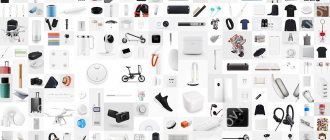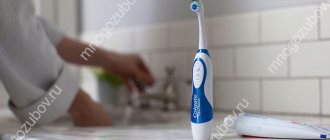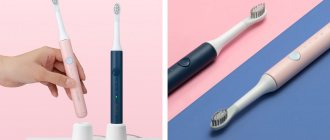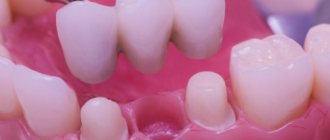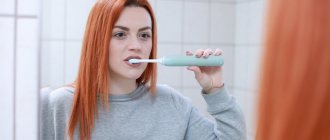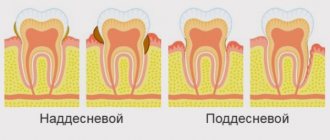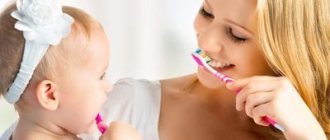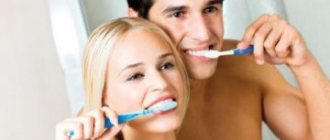To find out how effectively a patient brushes their teeth, dentists apply a compound that stains plaque. As a result, it becomes obvious that, despite regular use of a toothbrush, plaque accumulates in almost everyone and in the same places: near the gums and between the teeth. Let's figure out why this happens and how to avoid it.
As a rule, plaque forms in the same places: between the teeth and near the gums
Toothbrushes and brushing techniques
Most often, problems arise due to improper cleaning technique. If you use a regular toothbrush, hold it at a 45-degree angle to the surface of the tooth and move it away from the gum - only in this case will the plaque be removed. When moving left or right, it can become clogged in the gum, which leads to inflammation. In addition, the interdental spaces are not cleaned this way.
An electric toothbrush is easier to use - you just need to guide it along the teeth. The bristles on sonic brushes make about 30 thousand up and down movements per minute, and on ultrasonic brushes - about 100 million. This frequency allows toothpaste, water and saliva to quickly foam, washing the tooth from all sides with this flow and effectively cleaning plaque. It is impossible to achieve the same powerful cleaning with a regular toothbrush.
The bristles of electrical appliances make thousands of vibrations per minute and effectively clean plaque
In addition, electronic gadgets have different modes: gentle, intensive, whitening and others, as well as different attachments, for example, for cleaning teeth with braces or for additional polishing of enamel darkened by frequent coffee consumption.
The only negative is that dentists do not recommend using ultrasonic toothbrushes if you have braces, veneers, fillings and crowns. Their cleaning is so intense that it can lead to loss of fillings or breakage of braces. In this case, it is better to use electric brushes.
Purpose of devices
An electric brush is an excellent replacement for a regular brush.
But a simple toothbrush cannot clean your teeth of plaque and food debris the way an electric device can. A person uses a regular toothbrush for 3-5 minutes, as recommended by dentists. Only during this period of time is it possible to manually clean all surfaces of the teeth so as to remove plaque containing many unsafe microorganisms. But an electric teeth cleaning device helps to significantly save effort and time, because vibrating bristles remove dirt much faster.
When using an electric toothbrush, the bristles in it make a back-and-forth motion, and they can also move up and down. This promotes more thorough and faster cleaning, thanks to the vibration created by the motor. So the procedure takes about two minutes.
The irrigator is a modern device that copes with several tasks at once: it cleans hard-to-reach areas of the oral cavity, massages the gums, and prevents the formation of stones. With the help of the device, in a short period of time, food residues are removed where a regular or electric brush cannot penetrate. The device delivers a thin stream of water or a medicinal solution under strong pressure, which helps wash away food residues after brushing the toothbrush, strengthening and improving blood circulation in the gums.
How to use the irrigator correctly is written here.
The device is equipped with a reservoir for liquid and nozzles. There are two types:
- Stationary. Differs in power.
- Portable. The main feature is compactness.
An irrigator is an excellent device for daily use, as well as for the treatment of periodontal disease and other diseases of the oral cavity when using special medicinal decoctions or solutions.
Irrigators for cleaning
An irrigator is a device that washes away plaque with water pressure and washes away food debris from the interdental crevices. It can be called a gentle alternative to dental floss.
The irrigator is indispensable when caring for teeth with braces or implants, because it carefully cleans the most inaccessible places and does not injure the tissue. The jet pressure is adjustable, and the device can also be used to hydromassage the gums to stimulate blood circulation.
In addition, you can fill the irrigator not with water, but with a composition for rinsing the mouth.
A stream of water released under pressure gently cleans teeth without injuring soft gum tissue.
Can one replace the other?
The key tool for oral care is an electric toothbrush. Additional tools and innovative devices can improve the quality of cleaning the oral cavity, teeth, the space between them, gums and the surface of the tongue.
An irrigator cannot completely replace a brush. The devices differ in purpose, but can be combined with each other, thereby improving the quality of cleaning and keeping teeth healthy.
Using an irrigator cannot replace constant cleaning with electrical appliances. To preserve dental health, it is recommended to use comprehensive care products. That is, use not only a brush and irrigator, but also floss and a special tongue scraper.
Dental floss
Nylon floss is used to clean the interdental spaces. It is pulled between the teeth, covering each one in turn so that it forms the letter “C”. Floss scrapes off plaque with more force than a waterpik. Because of this, debate continues about whether dental floss is useful: some doctors believe that it can injure soft tissues, and in cases where the gums have receded, partially exposing the root, using it can simply be painful.
When brushing, the dental floss should wrap around the tooth in a semicircle.
Most dentists agree that waterpik and dental floss are effective in different situations. The first is suitable for daily cleaning, and the second can be used when necessary and remove more durable plaque deposits.
Advantages of an ultrasonic brush
- Cleanses the entire oral cavity.
- Has an antimicrobial effect.
- Thanks to ultrasound, soft deposits are removed from teeth.
- Easily penetrates the most inaccessible places.
- Reduces the likelihood of gum inflammation.
- Increases blood circulation in the gums, which improves the supply of nutrients from toothpaste.
- Teeth cleansing is achieved in half the time than with a regular toothbrush.
- Can be used from 5 years of age, only under strict adult supervision.
Although the device has a number of advantages, there is a category of people who do not want to use an ultrasonic brush:
- People who have a large number of fillings, as well as pins and crowns.
- People with a thin coating of tooth enamel.
- Frequent gum diseases.
- The use of an electric device for brushing teeth is strictly prohibited for pregnant women, cancer patients and patients with a pacemaker.
Types of irrigators
When choosing a device for home use, you should study their varieties. Based on the principle of use, irrigators can be divided into 2 types: stationary and portable.
Stationary devices are ideal for the whole family. They have more power. They require a continuous connection to the power grid and are constantly stored in the user’s bathroom. Their use is distinguished by a fairly high level of convenience, but only at home;
The design of portable irrigators contains a battery that must be charged from the mains for further autonomous operation. Such a device is convenient because it can be used without a constant connection to the network. You can take it with you everywhere, which is why it is also called a travel irrigator or a mini version. It is optimal to use a portable irrigator at the dacha, on a business trip or on the road.
In addition, it is possible to divide the devices according to the operating principle:
- Monojet. Food particles are washed away with a stable and continuous flow of water. They are highly effective, although they can cause discomfort in young children.
- Pulse. Water is supplied in short, frequent pulses, which is almost not felt by a person. The power of such irrigators is quite high, so they also have high cleaning efficiency;
- Microbubbles. Liquids saturated with oxygen are good for getting rid of impurities in the oral cavity. Microscopic bubbles explode upon impact and wash away food located between the teeth. This type of device appeared relatively recently, but has already become quite popular because it has shown excellent performance.
How to choose
When choosing an ultrasonic brush for cleaning your teeth, you need to pay attention to:
- Head shape. It is better to choose a round brush - it is more effective in cleaning.
- The handle of the device should be rubberized for ease of use.
- Presence of a timer and pressure sensor and battery charge.
- Availability of several nozzles.
- Availability of several operating modes.
The use of a brush with ultrasound has a positive effect on the health of the oral cavity and teeth in particular. The effect is noticeable after several cleaning procedures. Whether it is better or worse than an irrigator - you will be able to determine this only after using these two devices.
Expert opinion: will a waterpik replace a toothbrush?
Often, an oral irrigator is a mysterious device for the average person, which, many believe, can completely replace cleaning the oral cavity with other means. According to others, it is a highly advertised useless device. To dispel all the myths, we turned to the specialists of the ANO “Association “Dentistry”.
Our questions were answered by the head of the treatment and prophylactic department, dentist-therapist, periodontist Nina Zakharova.
– Nina Igorevna, tell us, in what cases is it recommended for a patient to use an irrigator and brush teeth under pressure?
First of all, if a person has crowded teeth, there are braces or veneers, crowns, and periodontal pockets. Many people use this device to feel clean in their mouth. The principle of its operation is quite simple: the surface is treated with a strong stream of water, which removes food debris from hard-to-reach places.
– What should be the temperature of the water poured into the irrigator?
The temperature should be about +40 °C, because cold water can negatively affect the enamel and increase tooth sensitivity. – How to use the irrigator correctly? It is necessary to begin cleaning in a gentle mode, gradually increasing the pressure. In addition, to create a feeling of a pleasant fresh smell, you can optionally add rinse aid to the irrigator reservoir. The irrigator must be held at an angle of 90 degrees to the area currently being treated, gradually moving from tooth to tooth. The head must be tilted so that during cleaning the already used liquid flows freely from the mouth.
– What should I do if my gums bleed when using an irrigator?
We need to reduce the pressure and pay more attention to this area! In any case, consultation with a dentist is necessary.
– Probably the most interesting question: is it possible to use only a waterpik instead of a toothbrush?
There are many different means of dental prevention: the most common is, of course, toothbrushes; the market offers all sorts of options, ranging from the simplest to electric. In addition, dental floss, rinses and balms are used. After these products we can call oral irrigators. There is an opinion that irrigators are a universal device for cleaning the oral cavity, that they can replace all hygienic devices and provide the necessary cleanliness. But this is far from true. Oral hygiene should be carried out in combination with all these means. Let me also remind you that the patient also needs to remember to visit the dentist twice a year.
Varieties
Depending on the type of food:
- From the battery, which is recharged from the stand included in the kit.
- Battery operated - perfect for people who travel frequently.
In the direction of movement of the head bristles:
- The bristles move from one side to the other.
- The bristly head rotates around its axis.
- The bristles move in different directions.
- The villi move with accompanying vibration.
- The entire brush vibrates.
Useful tips
Let's summarize, or tips on how to choose an electric toothbrush for an adult:
- Please consult your dentist before purchasing. Your doctor will give you the most important advice based on your oral health.
- Don't waste money on a good toothbrush. It will cost less than treatment in a clinic.
- It is better to choose a device that comes with a small nozzle. It will help take care of hard-to-reach places.
- Please note that an electric brush requires a softer paste (look at the RDA tube, no higher than 50).
Inexpensive irrigator: is it necessary for dental care or not? I share my opinion after 2 months of use
Before I started treating my teeth and decided to get braces, I thought that one toothbrush, good toothpaste and mouthwash would be enough when caring for my teeth.
When I started treating my teeth ( before putting on braces
), my dentist recommended getting an irrigator. Like, for those who wear braces or crowns, it is absolutely necessary. And in general, for everyone who cares about their teeth, this is a necessary thing.
I began to study this issue, consult with people who use an irrigator. Everything seems to be as my dentist said: liquid under pressure washes teeth and gums perfectly, removes plaque much better than a regular brush (special emphasis was placed on cleaning plaque from the tongue), and in general - you can forget about the risks of caries and periodontitis, very good for gums. Well, you have to take it, since everything is so, and see for yourself. Which is what I did.
I'll tell you about my irrigator. I purchased an inexpensive stationary option - B.Well WI-922.
What is in the box
This is such a simple device. It is plugged into the network, the legs of the device have suction cups and do not slip on the tiles when you use the irrigator.
In the middle is a container with water. You can add a special liquid for irrigator ( with chlorhexidine and xylitol)
), this is for those who have implants or wear braces. But now I only pour ordinary water into the container. I just don't like the taste of this mouthwash.
Capacity 600 ml. For one cleaning and rinsing, 400 ml of water is enough for me.
Above the container is a case for attachments. There are several of them in the set.
I’ll write briefly about each attachment (currently I’m using one that’s specifically for braces).
So, from left to right in the photo above. The first three attachments are standard, for cleaning teeth from plaque, interdental spaces and for massaging gums.
The fourth attachment is a periodontal one, for cleansing the gingival margin ( that very place at the junction of teeth and gums, for those who don’t understand
) and gum pockets. The fifth is for cleaning implants, veneers and crowns. The sixth is mine, orthodontic, for cleaning teeth and braces. The latter is for removing plaque from the tongue.
First impression
I did everything according to the instructions: I poured irrigator rinse aid into the container and diluted it with water (in a ratio of 1 to 5). Then I set the intensity of the jet pressure (the round button under the container). I put the nozzle into my mouth so that the stream went at an angle of 90 degrees to the gum line at the far tooth. I closed my lips and turned it on and turned it on the handle itself from OFF to ON.
The pressure is gone, mom, don’t worry, the tooth is cold and unpleasant, it splattered all over the bathroom mirror :-))
My first mistake
– I used cool water, it is very unpleasant the first time. You need to initially pour warm water, and then you gradually get used to water at room temperature.
Second mistake
- strong pressure. The regulator must be set to at least half (a little more is possible). But never start from the far right position.
But all these are minor things, to be honest. I got used to the irrigator the second time around.
Further use
I use the irrigator after brushing. In fact, after the toothpaste I don’t even rinse my mouth, but immediately turn on the irrigator.
I use it twice a day, morning and evening. Sometimes in the middle of the day I can use a waterpik instead of a brush (I brush my teeth after every meal).
The main attachment for me now is the orthodontic one, sometimes I use the tongue attachment, but rarely, I find it more convenient to clean my tongue with a brush.
The set includes three standard attachments that can be used by the whole family. They are colour-coded, pink, blue and grey. I gave my husband a blue one and am slowly getting him used to cleaning with an irrigator. I don’t need the attachment for implants and veneers yet, but it will come in handy in the future when treatment on the bracket system is completed.
Irrigator or interdental brushes? What to choose?
Every person knows from childhood that to maintain oral hygiene you need to use toothpaste and a brush. But not everyone knows that a regular brush cannot always cope with plaque and food debris in the crevices between the teeth. The distances between the teeth are small enough for the brush to clean these spaces from bacteria, plaque, food debris, etc., which can lead to the formation of tartar, caries and inflammatory processes of the gums. When wearing braces, bridges, or implants, some difficulties arise, primarily related to hygiene. It is very difficult to clean teeth from food debris that gets stuck under the arch of braces, brackets and attachment points. Therefore, it is important to choose the right tool for careful maintenance. Only a dentist can completely remove all dental deposits, so professional hygiene must be done every six months. And at home, to maintain a good level of hygiene, you need to brush your teeth twice a day with a toothbrush and toothpaste - and additionally clean the spaces between your teeth using dental brushes and an irrigator.
Who needs dental brushes and irrigator?
- For those who wear braces, bridges, implants
- For those who drink a lot of strong tea and coffee, as well as for those who smoke
- For those with sensitive gums
- For those who have too small or large interdental spaces
- For ordinary people who closely monitor the condition of their oral cavity
In order to understand which of the proposed devices is better, we will conduct a comparative analysis.
Benefits of dental brushes:
- The brush consists of a handle and a rod with bristles. All brushes have different diameters, lengths and stiffness of bristles. What allows a person to choose the size he needs in accordance with the individual characteristics of the dentition
- If you have braces to correct your bite, dentures or bridges, the quality of teeth cleaning is reduced. A brush for cleaning teeth will help to cope with this problem, so for people with braces it is simply necessary
- their use is much more convenient than using dental floss
- they are safer than toothpicks because they cannot damage tooth enamel or gums
- have an additional unique property - they massage the gums, stimulating blood circulation in them and helping to strengthen
- effectively clean enamel from coffee, tea or tobacco stains, and also remove plaque that causes bad breath
- the small width of the villi allows them to penetrate into the periodontal pocket, cleaning the crowns below the gum line, which is a good prevention of gum inflammation
- the cost is lower than that of irrigators
Disadvantages of dental brushes:
- It is very important that the size of the brush is selected correctly and individually. To do this, you need to contact your dentist, who, using special calibration probes, will measure each interdental space and select the right brush size for you.
- many types of brushes are disposable
- require frequent replacement, which means material costs. It is recommended to change the brush every week (maximum use time is two weeks), even if visually it does not look deformed
- the cost of dental brushes may vary, but it is not recommended to purchase too cheap ones - their bristles quickly wrinkle and deform, which reduces the quality of cleaning
- Only when used correctly does a brush successfully remove food debris from the interdental spaces. Therefore, you need to learn the technique and devote enough time to effectively clean your mouth.
If you do not want to perform monotonous movements on your own or cannot master the correct technique, you can purchase special electric brushes or irrigators complete with a dental brush attachment. This is a device that consists of a reservoir for liquid and a handle with a nozzle for rinsing the interdental spaces.
Advantages of irrigators:
- After brushing your teeth with a brush and paste, you use an irrigator. This helps clean hard-to-reach spaces between teeth and prevent the formation of tartar.
- Cleans teeth and braces more effectively than brushes. A stream of water or a medicinal solution supplied under pressure better penetrates the interdental spaces and areas between the elements of the dental structure and washes out even microscopic food debris.
- massages the gums, improving their blood circulation
- indispensable for those who have crowns, bridges or braces, as well as for people with bleeding gums, frequent food getting stuck in the interdental spaces, crowded teeth (very close arrangement)
- a nozzle for interdental spaces, which can be used for an irrigator, is much safer than brushes, incorrect or careless handling of which can damage the bracket system
- There are several types of attachments, the choice of which depends on the purpose, orthodontic, periodontic, for cleaning the tongue
- perfectly cleans the space between teeth, while doing all the work for you
- The cleaning process using irrigators is much faster than when cleaning with a brush
Disadvantages of irrigators:
- high cost, but this is a one-time purchase and will last for a long time. Cleaners are cheaper, but you have to buy them much more often
- takes up more space in the bathroom
- higher noise level
- There is a danger of electric shock - do not touch the operating device with wet hands or use it when taking a bath or shower; do not immerse the irrigator in water
- requires regular washing and drying of nozzles, a special place for storing nozzles
If you are in doubt about what to buy: an irrigator or brushes, we recommend that you use a two-in-one product: an irrigator with attachments for cleaning interdental spaces.
Dental center Dentalpik (Dentalpik) Pro 50
Portable irrigator Dentalpik Pro 50 with a built-in battery, made in an ergonomic design. Effectively cleans the interdental spaces, removes plaque, and also prevents the formation of tartar and is an excellent prevention of caries and periodontal disease. An oral irrigator is necessary for caring for dentures, crowns and braces. The Dentalpik Pro 50 irrigator is easy to operate, convenient for transportation and use outside the home. Thanks to the built-in battery, the irrigator can maintain operation for up to 2-3 weeks without recharging. Additionally, there are orthodontic attachments and attachments for cleaning the tongue. In addition to the irrigator, the dental center's equipment includes the Dentalpik Pro 50 Ultrasonic Toothbrush. It operates at a frequency of 48 kHz, which is 48 thousand vibrations per minute, at a sound frequency of 42,000 mechanical movements per minute, which enhances the antibacterial and cleansing effect of the brush. 3 operating modes and improved battery. And the Dentalpik dental mirror with anti-fog coating and LED backlight will allow you to look into the most inaccessible places in your mouth, evaluate the quality of cleaning and the level of plaque on the inner surface of the teeth.
Dental center Oral-B Professional Care OxyJet Center +3000
This is a comprehensive system for caring for the entire oral cavity for superior cleanliness. Consists of an electric toothbrush and irrigator. Removes up to 97% of plaque from hard-to-reach areas of the oral cavity. The Oral-B Professional Care OxyJet irrigator is stationary. By turning on the Turbo flow mode, the mini-turbine built into the head of the nozzle is activated, which, spinning up to 8000 rpm, forms a spiral-shaped jet stream that easily penetrates under the edge of the gums, destroying bacteria, food debris, massaging the gums, and preventing periodontal diseases. Monoflow - a direct, directed jet stream attacks bacterial plaque, washing away food debris between teeth, around implants, crowns, bridges and orthodontic structures. The irrigator automatically turns off after 10 minutes of operation if you forget to turn it off manually, to prevent overheating. The Oral-B Professional Care electric toothbrush has a unique 3D technology: 40,000 pulsating movements/min, 8800 reciprocating movements/min. The pressure sensor, when the brush is pressed firmly on the surface of the tooth, automatically turns off the pulsating movements, thereby ensuring safe cleaning, preventing your teeth and gums from over-cleaning.
Irrigator Waterpik WP-100 Ultra E2
Effectively removes oral bacteria. Penetrates deeply between the teeth and under the gums, where a toothbrush and dental floss cannot reach. Ideal for improving the condition of gums during periodontitis and periodontal disease, as well as preventing these diseases during pregnancy and lactation, with diabetes, and in smokers. It has a quiet electric motor, 10 pressure levels and a set of 7 nozzles. One of the most useful attachments is for the hygienic care of dentures, bridges and implants. It allows you to spray an antibacterial solution or just water beyond the gingival margin, cleaning the periodontal pockets. Next is the necessary mono-beam brush attachment, which allows you to wash hard-to-reach areas and braces with a powerful jet. The nozzle with a nozzle for cleaning the tongue is made in the shape of a spoon. Periodontal nozzle with a soft rubber tip of a cone shape. It allows you to accurately direct the stream of liquid without injuring the gums with the plastic part, which is indispensable for cleaning gum pockets and massaging the gums. The irrigator is also equipped with an orthodontic attachment, which, thanks to the presence of a small brush at the end, allows you to effectively clean braces.
In conclusion, we note that for the best oral hygiene, it is recommended to use the following set: toothpaste, toothbrush, dental brush and irrigator:
- A toothbrush and toothpaste are the main means for cleaning the visible surface of teeth.
- A dental brush is the main tool for cleaning interdental spaces from food debris.
- An irrigator is the main tool for cleaning hard-to-reach places and strengthening gums
A dental brush is a good tool for cleaning the interdental space. However, people often do not master the regular and correct use of a dental brush for a number of reasons: laziness, limited physical capabilities, or the presence of orthodontic structures in the oral cavity. An irrigator is a more advanced device that allows you to remove food debris from places that are inaccessible even to brushes. It generates a strong stream of water, which easily penetrates both hard-to-reach places and deep periodontal pockets. The irrigator is indispensable for people who have crowns, implants, bridges, braces, veneers and can improve the condition of people with periodontitis, periodontal disease and bad breath. It is recommended to use brushes for cleaning teeth in combination with irrigators and special rinses designed for oral care. When used correctly and regularly, they will ensure healthy teeth and gums for a long time.
If you have any questions, we will help you choose from more than 40 models of irrigators and brushes presented on our website, just call us at: +7
